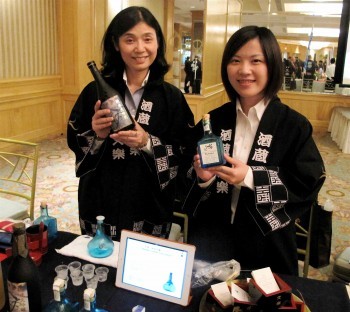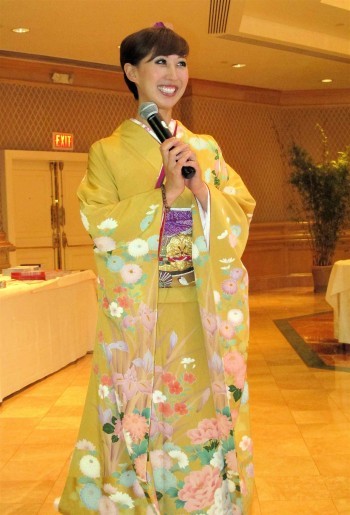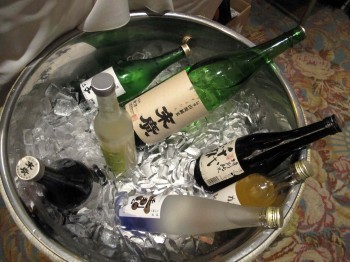Sip and savor sake
We’ve all been to wine tastings and beer tastings, but what about sake tastings? Discover Sake LA was a first sake tasting experience for me, even though I have always loved sake, especially since I took a trip to Japan about ten years ago. But at this enjoyable and informative event, I learned so much about sake and now I will savor it even more.
Sponsored by the Japan External Trade Organization (JETRO) and the Japan Sake and Shochu Makers Association, Discover Sake LA was held at the elegant Olympic Collection conference center in West Los Angeles. The event’s purpose was to promote sake in the United States. Exhibitors were sake brewers and importers, and attendees were primarily liquor retailers and restaurateurs.
A highlight of this very well-organized and well-attended event was the seminar beforehand with speaker, Timothy Sullivan, well known in the sake world as the “Sake Samurai.” This title represents a very distinct honor bestowed on Mr. Sullivan in 2007 by the Sake Brewers Association of Japan because of his efforts to educate the public and promote the art and culture of sake all over the world. He is the founder of the popular, informative website, UrbanSake.com.
His presentation was enlightening and entertaining. Here are just a few of the fascinating facts we learned about sake:
• Imports of sake to the United States have doubled in the last ten years and the demand for sake continues to increase.
• While many people describe sake as “rice wine,” it is not really wine. Wine is made from fermented fruit while sake is made of rice, water, yeast and a microorganism called koji, which are all combined in a unique fermentation process. Sake is also not a spirit. It is in its own category of alcoholic beverages.
• Sake is not as high in alcohol as many people assume with the average alcohol percentage ranging from 13 to 16 percent, very similar to the alcohol in a good bottle of wine.
• Like wines, there are numerous varieties of sake with distinct tastes and bouquets. Some sakes are fortified with alcohol while others are made from pure rice. Different sakes are made with different brewing methods, but the quality of the water is always very important.
• Sake is more robust than wine once it is opened and can last 2-3 weeks without losing its taste or vitality.
• Sake can be successfully paired with all kinds of foods, not just with sushi and Asian food. Its unique acid balances and flavors can enhance many dishes, including those made with beef and seafood.
Mr. Sullivan made the point that the quality of sake has never been better and we were about to experience that quality firsthand. Over100 types of sake were available for sampling at Discover Sake so it was impossible to taste them all (at least for me), but let me describe the five distinctly different sakes that were presented at the end of Mr. Sullivan’s presentation:
Hideyoshi Honjozo–lightly fortified, with an almost earthy rustic rice flavor and hints of rye and oats.
Mizunoshirabe Ginjo—light clean taste with a silky, smooth texture and very gentle finish.
Kirinzan Junmai Daiginjo—crisp, clean, and elegant with fruity aromas and taste.
Dassai Sparkling Nigori 50—sparkling with less aggressive bubbles than champagne, fruity with nice acidity.
Yuzu Omoi—high acidity, lemon-orange citrus flavor, very refreshing.
 As I walked around the tasting room, I sampled many different sakes and also tasted two delicious sake cocktails made with juices and garnished with orange slices. I was particularly impressed with the enticing, stylish bottling and labels. As is true throughout the Japanese culture, presentation is almost as important as the beverage inside the bottles. Adding to the authentic Japanese atmosphere of the afternoon were the many exquisitely attired and gracious hostesses in their colorful kimonos. And the lovely singing and music being played in the background enhanced the beauty and richness of the tasting experience.
As I walked around the tasting room, I sampled many different sakes and also tasted two delicious sake cocktails made with juices and garnished with orange slices. I was particularly impressed with the enticing, stylish bottling and labels. As is true throughout the Japanese culture, presentation is almost as important as the beverage inside the bottles. Adding to the authentic Japanese atmosphere of the afternoon were the many exquisitely attired and gracious hostesses in their colorful kimonos. And the lovely singing and music being played in the background enhanced the beauty and richness of the tasting experience.
 We learned that while most Americans think of sake served warm, it can be just as delicious served chilled or at room temperatures as most of the sakes were served at this event. (I particularly love cold sake with a slice of cucumber.) The higher the quality of the sake the more sensitive it is to temperature. Some sakes taste better warm and others are more flavorful when cold.
We learned that while most Americans think of sake served warm, it can be just as delicious served chilled or at room temperatures as most of the sakes were served at this event. (I particularly love cold sake with a slice of cucumber.) The higher the quality of the sake the more sensitive it is to temperature. Some sakes taste better warm and others are more flavorful when cold.
I left Discover Sake contemplating all kinds of interesting food pairings with sake that I could try at home. How about Thanksgiving dinner with sake instead of wine? How about a sake cocktail with cheese and crackers? How about sake with a light seafood pasta dish? How about sake with a blackened steak off the grill? We plan to have fun serving sake paired with a variety of foods at our house. So I hope you will enjoy sake too and don’t forget to toast your friends with the familiar Japanese toast: “Kampai.”

